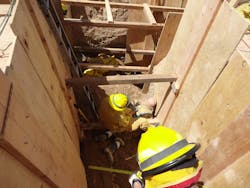Technical Rescue: The Progression of Trench Rescue Operations
Trench rescues have been a common technical rescue operation since the advent of underground utilities. Occupational studies show that the construction and utility industries are continuing to suffer hundreds of fatalities and thousands of injuries in trenches, meaning those of us in the fire service will continue to be called in to deal with these emergencies.
For years, the evolution of trench rescue techniques has occurred through trial and error, with the impression that we operate in the “rescue world,” unencumbered by regulatory confines. Nothing could be further from the truth. OSHA is very clear in its direction that trenching and excavation regulations apply to trench rescue operations in the same manner as construction work.
The Code of Federal Regulations 1926.650-652 sub-part P (your state regulation will prevail if you have a state OSHA) is the directive for work in trenches and excavations, regardless of the purpose for work in the trench. This should come as no surprise when you consider that the biggest risk in trench work is collapse of the trench walls, and those trench walls are 100 percent non-discriminatory as to who they will collapse on and when. In fact, as rescuers we are at statistically significant risk, as we know that following an initial collapse, there is a 60 percent chance of a secondary collapse. Following a trench incident, OSHA will hold all parties working within the trench accountable to the trenching and excavation regulations.
Shoring options
As we began to develop the updated Trench Rescue Technician curriculum for California State Fire Training, we realized that many of our techniques were handed down informally and therefore not defendable if we were to be investigated by OSHA in a post-incident investigation. The regulation provides clear direction on when protective systems must be provided. It then goes on to state that support systems must be constructed in accordance with one of four options listed in the regulation, and then provides the four basic options for the design and construction of shoring support systems:
- Option 1: Shoring systems using the appendices found within the regulation
- Option 2: Shoring systems using the manufacturer’s tabulated data
- Option 3: Shoring systems using other tabulated data
- Option 4: Shoring systems using tabulated data developed for the task by a registered professional engineer (RPE)
The regulation also states that the required tabulated data must be available at the worksite during construction of the support system, and that when utilizing options 2 through 4, it must identify the RPE approving the design of the shoring system.
A review of the tabulated data in the regulation (option 1) revealed that it utilized timber shoring that was way too large and not readily available. Using the manufacturer’s data (option 2) worked well when using purchased shoring, such as pneumatic shoring or hydraulic shoring, but couldn’t be utilized for other types of shoring. Finding tabulated data that was already developed by an RPE (option 3) for our needs resulted in a dead end. We were left with trying to find an RPE to develop tabulated data for utilizing timber shoring in trench rescue operations (option 4).
By working with OSHA during the training program development, utilizing an RPE to develop tabulated data for timber shoring, and adhering to NFPA directives for a trench rescue technician, we were able to develop a training program that adapts to various collapse patterns, is defendable based on the regulation, and provides a practical approach to trench rescue operations.
Tactical priorities
Like all technical rescue disciplines, trench rescue is no different in that we must first determine our tactical priorities. If we don’t, we place personnel at significant risk with no potential gain, we perform tasks that do not increase the survival profile of the victim, and we waste time doing things that do not get us closer to our ultimate goal of a live rescue.
As we approach the problem, we need to consider many things, including but not limited to approaching the trench from the head of the trench, locating the responsible party, determining control zones, shutting down equipment, confirming that the underground utilities have been located, etc.
While many things may be happening early in the incident, you will need to get four things handled early, and these four things need to be your tactical priorities to begin moving in the right direction.
- Assign a safety officer: This position may be held by yourself initially and later may be assigned to an individual who is trained in trench rescue who can focus just on safety issues. Having this position assigned helps meet other regulatory issues that come up following the incident.
- Get ladders in the trench: The regulation requires that when trenches are 4 feet or deeper, there must be egress provided within 25 feet of the worker in the trench. Remember the ladders initially placed in the trench are not necessarily for the victim; they are for any rescuer who may inadvertently fall into the trench.
- Provide edge protection on the trench lip: The material used for edge protection can be just about anything that will distribute the weight of rescuers, decreasing the chances of creating a situation where the lip fails. It also creates a clearer surface to work from.
- Clear spoil: The soil that has been removed from the trench creates a surcharge load on the trench lip, increasing the chance of a lip failure. It also continues to fall into the trench depending upon the grade or height of the spoil pile.
While your first four tactical priorities are moving forward, you need to identify a responsible party and ask them some critical questions, such as:
- What type of work are you doing in the trench? New trenches in virgin soil vs. repair work in import soil can result in significant differences in soil performance.
- How many personnel were working in the trench, and where were they last seen?
- How long have they been trapped in the collapse?
- How deep is the trench? While this question seems rudimentary, knowing this fact keeps rescuers from digging deeper than the original trench depth looking for victims, and helps determine material needs for the ultimate shoring depth.
As we approach the trench and assess the conditions, we should be doing that same six-sided approach that we perform when doing emergency building shoring:
- Top: Check the lip for fissures, check for spoil piles too close or too high, and look at trees that could be compromised because of the trench collapse near the root system or other structures, such as light poles, etc., that have been compromised by the collapse.
- Four sides: Check the trench walls for fissures, bulging, water seepage or voids.
- Bottom: Check the bottom for bulging, water seepage, etc.
While some departments consider a trench to be a confined space, the regulations do not. Appropriate margins for safe trench operations are found in the trenching and excavations orders. One example of that is the trenching regulation stipulation that trenches must be monitored if there is any reason to believe that a hazardous atmosphere could develop. With that said, once we have approached the trench from the head, done a six-sided approach and size-up, completed our first four tactical priorities, performed atmospheric monitoring (if needed) and questioned our responsible party, we must begin to develop a shoring strategy.
Your shoring strategy will be impacted by many factors, with some of the biggest being the type of trench collapse, where the victim is located and the equipment you have available. The regulation dictates that the shoring system will be contingent upon the width of the trench, the depth of the trench and the type of soil.
If you are an organization blessed with a large inventory of pneumatic shores and/or hydraulic shores, and the trench collapse configuration accommodates, you will be able to get much of your initial shores in without even entering the trench. If not, you will have to use timber shoring. Regardless of which way you go, your plan will ultimately end up working from the intact trench toward the collapse site from one or both sides or directly over and down on the collapse site. In addition, the shoring plan you use will need to have tabulated data approved by an RPE to defend it should OSHA request it in a post-incident investigation.
All of the manufactured shoring devices have tabulated data available. It is the improvised timber shoring techniques that we have used with great success that we could not defend with tabulated data from an RPE.
Timber shore tabulated data
What trench rescue teams needed was tabulated data that allowed them options for installation utilizing materials that were more readily available than much of the large dimensional lumber found in the regulation. Through an exhaustive search, the Trench Rescue Technician working group was able to find an RPE who was willing to work with us. His commitment to assisting rescue teams in trench rescue has provided every one of us an invaluable resource.
His work has allowed us to safely and legally utilize three-quarter-inch 5-ply construction-grade plywood with 2 x 12 strong-backs as panels. It allows us to utilize 4 x 4 construction-grade lumber as cross-braces/struts or as Walers. It provides direction on the complete shoring system, whether it be the strong-back/upright and panel system, the Waler system or the complete end-shore system to secure a wide end to a trench or a box trench. The timber data provided also allows us to incorporate other equipment like Ellis post-screws, pneumatic shores, and hydraulic shores into the system as long as we do not exceed the limitations provided by the manufacturer on their tabulated data. The trench rescue tabulated data can be used in type C soils anywhere in the United States as long as it is used for the purpose of rescue. This information provides us the opportunity to defend our shoring plan, be in compliance with trench regulations, utilize materials that are more readily available and affordable, adapt to varied trench conditions, and develop standard procedures that can be utilized throughout the country.
The shoring tabulated data can be found at http://www.firehouse.com/document/12188730/trench-rescue-shoring-tabulated-data.
Final notes
While this information is a valuable addition to our trench rescue program, it does not take the place of realistic hands-on training and the realization of some basic unchanging truths of trench rescue incidents: Trench rescue operations are personnel-, time- and resource-intensive; trench rescue personnel must work within protective systems; shoring systems will be determined by width of trench, depth of trench and type of soil; and shoring systems must be compliant with trenching and excavation regulations.
About the Author

Kent Freeman
Kent Freeman is a 30-year veteran of the fire service. He retired from the Roseville, CA, Fire Department, where he served as the coordinator of technical rescue services. Freeman served as the project leader for the Confined Space Rescue Technician program of the California State Fire Training Division (CSFT) and served on the working group for the development of the CSFT’s Trench Rescue Technician program. He remains active in teaching programs for fire departments and private industry.
